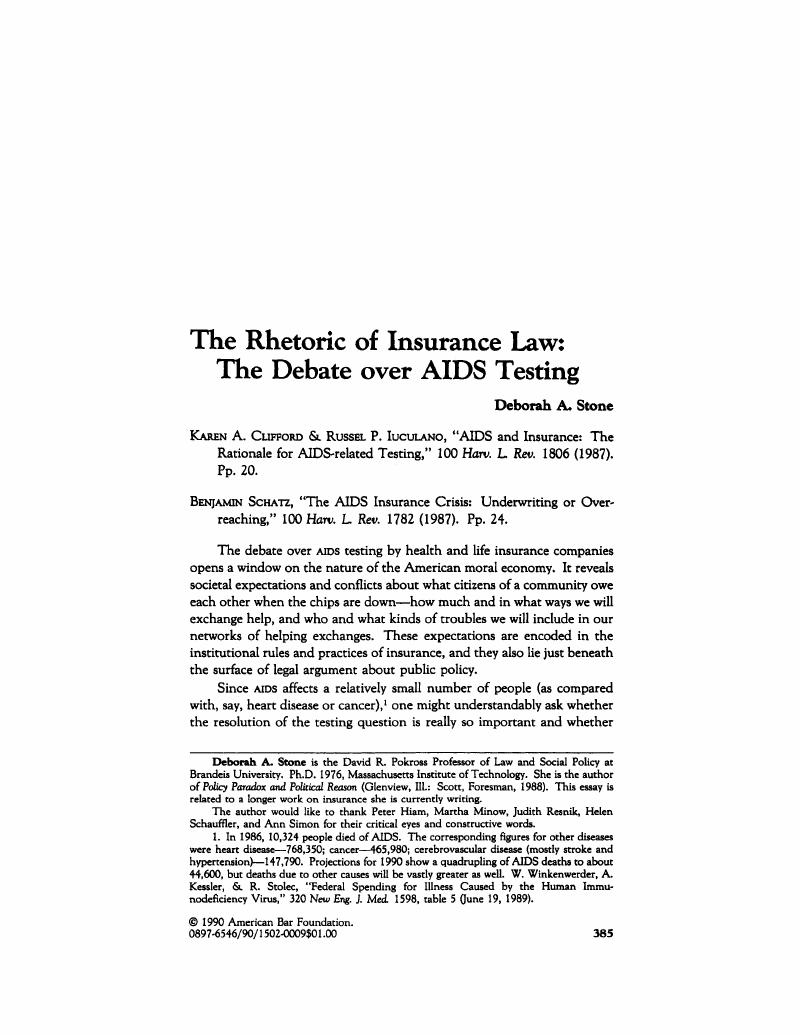Published online by Cambridge University Press: 27 December 2018

1 In 1986, 10,324 people died of AIDS. The corresponding figures other diseases were heart disease—768,350; cancer—465,980; cerebrovascular disease (mostly stroke and hypertension)—147,790. Projections for 1990 show a quadrupling of AIDS deaths to about 44,600, but deaths due to other causes will be vastly greater as well. Winkenwerder, W., Kessler, A., & Stolec, R., “Federal Spending for Illness Caused by the Human Immunodeficiency Virus,” 320 New Eng. J. Med 1598, table 5 (June 19, 1989).CrossRefGoogle Scholar
2 Schatz, at 1788–89 n.47.Google Scholar
3 Iuculano writes and testifies frequently on the industry position. See, e.g., “Life Insurance,” in William H. L. Dornette, ed., AIDS and the Law (New York: John Wiley, 1987), and “D.C. Act 6–170: The Five-Year Ban on Risk-based Pricing for AIDS,” 2 AIDS & Pub. Pol'y J. 15 (1987). Other analyses of the problem from a gay rights perspective include Benjamin Schatz, “The Crisis in AIDS and Health Insurance,” 16 Barrister 45 (1989); Mark Scherzer, “Insurance,” in Harlan Dalton, ed., AIDS and the Law (New Haven, Conn.: Yale University Press, 1987); Id., “AIDS and Insurance: The Case Against HIV Antibody Testing,” 2 AIDS & Pub. Pol'y J. 19 (1987); and Nancy Perkins, “Prohibiting the Use of the Human Immunodeficiency Virus Antibody Test by Employers and Insurers,” 25 Harv. J. Legis 275 (1986).Google Scholar
4 Joseph Gusfield, The Culture of Public Problems (Chicago: University of Chicago Press, 1981).Google Scholar
5 I know of only two exceptions. In 1987, the Massachusetts Division of Insurance surveyed life insurance companies doing business in the state about their claims experience with AIDS, and tried (unsuccessfully) to use the findings to restrict insurers' use of HIV testing in the state. See Peter Hiam, “Insurers, Consumers, and Testing: The AIDS Experience,” 15 Law, Medicine and Health Care 212 (1987/88). The Office of Technology Assessment conducted a major survey of insurance company underwriting practices for its report, Medical Testing and Health Insurance, Doc. No. OTA-H-384 (Washington, D.C.: Government Printing Office, Aug. 1988) (“OTA, Medical Testing”). Even this survey, however, was designed in cooperation with, and endorsed by, the HIAA and the Group Health Association of America (a trade association of health maintenance organizations and other prepaid group health plans). Id. at 55.CrossRefGoogle Scholar
6 In the OTA survey, which seems to be the best (if not only) data on the question, 86% of commercial companies, 73% of Blue Cross-Blue Shield plans, and 50% of health maintenance organizations said they either screened or planned to screen individual applicants for AIDS, OTA, Medical Testing, 80–90.Google Scholar
7 Seventy-seven percent of commercial small-group insurers, 58% of commercial large-group insurers, 77% of Blue Cross-Blue Shield small-group plans, and 77% of Blue Cross-Blue Shield large-group plans either screened or planned to screen for high-risk applicants. OTA, Medical Testing 80, 85.Google Scholar
8 American Council of Life Insurance, 1986 Life Insurance Fact Book 30 (Washington, D.C.: American council of Life Insurance, 1987). Clifford and Iuculano at n.18.Google Scholar
9 In response to pressure from gay rights advocates, the MIB has modified these data-sharing policies for AIDS antibody tests. It announced in 1987 that it will no longer keep records of positive HIV test results; and it now codes these results as “abnormal blood count.” OTA, Medical Testing 80. Still, it is not clear that this new coding method offers any great protection. Since insurance underwriters know what it means (or can mean), they may simply reject applicants with this code.Google Scholar
10 Bailey, Herman T., Hutchinson, Theodore M., & Narber, Gregg R., “The Regulatory Challenge to Life Insurance Classification,” 25 Drake L. Rev. 779 (1976). All three authors were listed at time of publication as counsel for Bankers' Life Company.Google Scholar
11 Quoting from id. at 780.Google Scholar
12 Quoting from id. at 782, who in turn quote Mowbray, A., Blanchard, R., & Williams, C., Insurance 411 (6th ed., 1969).Google Scholar
13 In a footnote, Clifford and Iuculano recognize that there are laws prohibiting use of sickle-cell trait in actuarial rating. But they use the footnote to explain that the sickle-cell trait doesn't usually increase the risk of illness or death, and so they feel justified in dismissing these laws as irrelevant.Google Scholar
14 For a lengthier discussion of the social construction of risk factors and high-risk people, see my “At Risk in the Welfare State,” 56 Soc. Res. 591 (1989).Google Scholar
15 The point is argued quite compellingly by Elvia Rosales Arriola, “Sexuality and the Constitution,” 10 Women's Rts. L. Rep., 143 (1988) (arguing that sexual orientation/sexual preference should be considered a suspect class for purposes of fourteenth amendment jurisprudence).Google Scholar
16 Barbara Underwood addresses exactly this question in “Law and the Crystal Ball: Predicting Behavior with Statistical Inference and Individualized Judgment,” 88 Yale L.J. 1408 (1979). She winds up in the same place as Schatz—that is, finding acceptable those classifications based on voluntary or controllable behavior—but she gives a more thorough defense of the position.CrossRefGoogle Scholar
17 National Academy of Sciences, Confronting AIDS—Update 1988 51 (Washington, D.C.: National Academy Press, 1988).Google Scholar
18 Scitovsky, A., Cline, M., & Lee, P., “Medical Care Costs of Patients with AIDS in San Francisco,” 256 J. Am. Med. A. 3103 (1986).CrossRefGoogle ScholarPubMed
19 See Daniel Goleman, “Researchers Find That Optimism Helps the Body's Defense System,”N.Y. Times, Apr. 20, 1989, at B15. Several mass-market books have popularized the theory that immune systems are subject to psychogenic influences, e.g., Norman Cousins, Anatomy of an Illness (New York: W. W. Norton, 1979); and O. Carl Simonton & Stephanie Matthews, Getting Well Again (Los Angeles: J. P. Tarcher, 1978).Google Scholar